Archived Blog Posts
Stop, Drop, and Use: A Guide to Properly Using a Fire Extinguisher
4/18/2023 (Permalink)
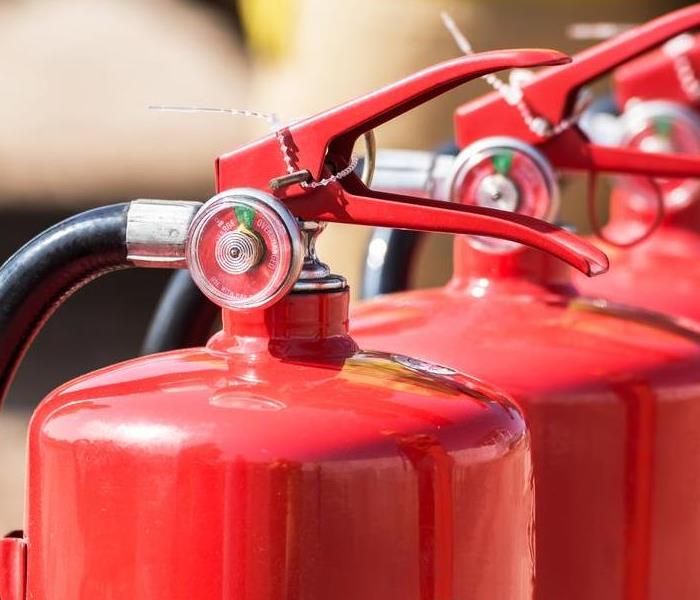 Knowing how to use a fire extinguisher can mean the difference between a small fire and a major disaster.
Knowing how to use a fire extinguisher can mean the difference between a small fire and a major disaster.
Fire extinguishers are an essential tool for any home or business owner to have on hand in case of emergency. But do you know how to use one properly? In this guide, we'll walk you through the steps to take if you need to use a fire extinguisher to put out a small fire.
Step 1: Assess the Situation
Before you attempt to use a fire extinguisher, it's important to assess the situation and make sure it's safe to do so. If the fire is too large, or if you don't have the proper training or equipment, you should evacuate the building and call the fire department. Only attempt to use a fire extinguisher if the fire is small and contained, and you feel confident in your ability to use the extinguisher.
Step 2: Pull the Pin
The first step in using a fire extinguisher is to pull the pin located at the top of the extinguisher. This will break the seal and allow you to discharge the extinguisher.
Step 3: Aim at the Base of the Fire
Next, aim the nozzle of the extinguisher at the base of the fire. This is where the fuel source is located, and targeting it directly will help to extinguish the flames more quickly.
Step 4: Squeeze the Handle
Once you have aimed the extinguisher at the base of the fire, squeeze the handle to discharge the extinguishing agent. Use a sweeping motion to cover the entire area of the fire, moving back and forth until the flames are extinguished.
Step 5: Evacuate the Area
Even if you have successfully put out the fire, it's important to evacuate the area and call the fire department. They will need to inspect the area to make sure the fire is completely out and that there are no hidden hot spots that could reignite.
Remember, time is of the essence when it comes to a fire. The longer you wait to try and extinguish a small fire, the greater the risk of it spreading and becoming uncontrollable. That's why it's important to not only have a fire extinguisher on hand but to also know how to use it properly. By following these steps and having the necessary equipment on hand, you can have peace of mind knowing that you are prepared to handle a small fire in the event of an emergency.
Knowing how to use a fire extinguisher can mean the difference between a small fire and a major disaster. Remember to always assess the situation before attempting to use an extinguisher, aim at the base of the fire, and evacuate the area after the fire is out. If you ever encounter a fire that is too large or dangerous to handle on your own, don't hesitate to evacuate and call for professional help. At SERVPRO of Montclair/West Orange, we are always here to help in case of fire or other disasters. Stay safe, and don't forget to check your smoke detectors regularly!
How To File An Insurance Claim After Water Damage In 5 Easy Steps
3/18/2023 (Permalink)
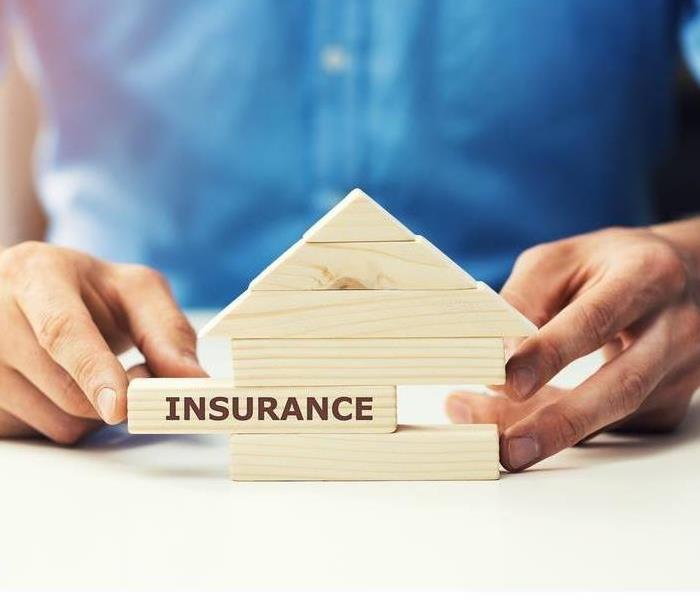 If your home or property suffers from a water loss, get the right help!
If your home or property suffers from a water loss, get the right help!
When a water damage event occurs in your home, it can be hard to know how to file an insurance claim, especially if you have never experienced a water loss before. Here are the steps you need to follow to make sure you're doing everything right.
Stop the water flow.
If your home has suffered from a water leak, the first thing you should do is stop the flow of water. To do this, locate the source of your leak or flood and turn off its main shut off valve. If there isn't one nearby--or if there is but it's inaccessible due to debris or other obstructions--shut down individual valves for individual rooms as well as any electrical outlets that may be affected.
Make a claim with your insurance company.
Next, it's time to call your insurance company and begin your claim. This is something that should be done as soon as possible. If you wait too long, they may not cover all of your losses or they may try to deny coverage.
Here's what you need:
- Personal information
- Your policy number
- Details about what happened
Take pictures of the damage.
Next, you need to take pictures of the damage as soon as possible. This will help your adjuster determine what needs to be replaced and how much it will cost to fix. You'll want to take pictures from different angles so they can see everything that was damaged, including any damage done to the structure itself, property, and contents.
Get your home inspected.
After calling your insurance company and filing a claim, it is important to get your home inspected by an adjuster. Usually, the insurance company will provide this service to you. The adjuster will look for evidence of water damage and document the extent of the damage. They will also inspect other structural elements like baseboards and trim boards as well as electrical outlets and switches to locate all the damage.
Call a water mitigation company.
You've probably heard the term "water mitigation" before, but you may not know exactly what it means. A water mitigation company is a professional who specializes in cleaning up water damage.
After calling your insurance company, you need to call one of these professionals as soon as possible. Your insurance company should be able to recommend several local companies that can do this work for you--or if they don't have any recommendations, you can look online for some yourself. This is an important step in order to prevent any secondary damage, such as a mold infestation due to water sitting unattended for an extended period.
Knowing how to file an insurance claim will help you get what you need from your insurance policy.
When you have water damage to your home or business, knowing how to file an insurance claim after water damage will help you get what you need from your insurance policy. The sooner you file a claim, the better. Take pictures of the damage and send them to your insurance company right away so they can start processing it.
If you have water damage, getting the right help can be very important. Our SERVPRO of Montclair/West Orange team is here to help with all your water damage cleanup and restoration needs. Our team will also assist you with the insurance claims process to ensure that you receive accurate compensation.
5 Reasons to Hire a Mold Remediation Pro
2/16/2023 (Permalink)
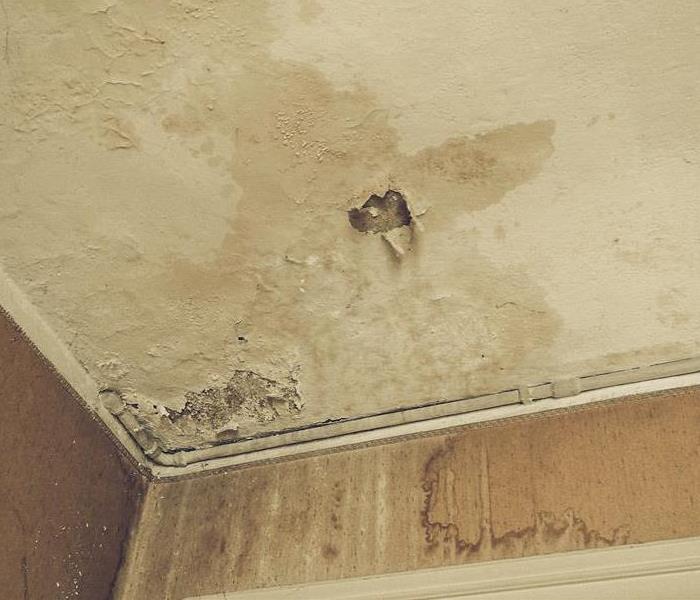 When you have a mold problem, call in a professional mold removal service.
When you have a mold problem, call in a professional mold removal service.
Mold remediation is a job for professionals. If you've found mold in your home and are trying to clean it up yourself, you may think that you're saving money by doing the work on your own. However, this could be one of the most costly mistakes you ever make! Here's why:
1. Mold Cleanup is Not Easy
Mold remediation is no easy task: It takes time and effort to safely remove mold from surfaces in your home or office space. The process can also be dangerous if proper precautions aren't taken.
Mold remediation is a specialized job, and it requires the right equipment and training to be done properly. If you're not sure about what you're doing, it's important to hire a professional. Even if you are an experienced DIYer, there are some things that should be left up to those who know better -- especially when it comes to your health and safety!
2. Specialists Will Prevent Mold from Spread
If you're not a professional, it can be difficult to know how to properly clean up mold in your home. Mold specialists will control and reduce the potential spread of mold by using proper equipment and techniques that avoid spreading spores throughout your house. They'll also be able to identify any hidden areas of contamination that may not be visible to the naked eye, so you don't have any lingering problems after they leave.
3. They Have the Knowledge, Training, Experience, and Equipment
Mold remediation is a specialized field. Mold removal professionals have knowledge, training, equipment, and experience in removing mold from your home or business. They know how to safely remove the mold with minimal disruption to you and your family's lives.
4. Can Save you Time and Money
The biggest benefit of hiring a professional for mold remediation is that you'll save time and money. A professional can complete the job in less than half the time it would take you, which means you'll have more free hours in your day to spend on other tasks.
When it comes to saving money, the cost of hiring an expert is often much less than what most homeowners would spend on DIY methods or products, especially if the mold problem isn't remediated properly. An experienced contractor will know exactly how much work needs to be done and won't waste any resources.
5. Will Prevent Future Mold Problems
If you want to prevent future mold problems, it's important to hire a professional. Mold can grow in places you don't expect and spread very quickly. It can also grow in small spaces, including those that are hidden or hard to reach. Mold spores are everywhere, so they will be present in your home whether you have a problem with them or not. They can cause serious damage if left untreated for long periods of time.
Call in a professional mold removal service
When you have a mold problem, call in a professional mold removal service. Mold remediation is not easy, and most homeowners lack the knowledge, equipment, and experience to properly handle it. A qualified company will control and reduce the potential spread of mold as well as save you time and money by preventing future mold problems from occurring. They may also be able to help with insurance claims if your home suffers structural damage due to water and mold damage. If you have a mold problem, call SERVPRO of Montclair/West Orange.
Common Causes for Basement Flooding
1/23/2023 (Permalink)
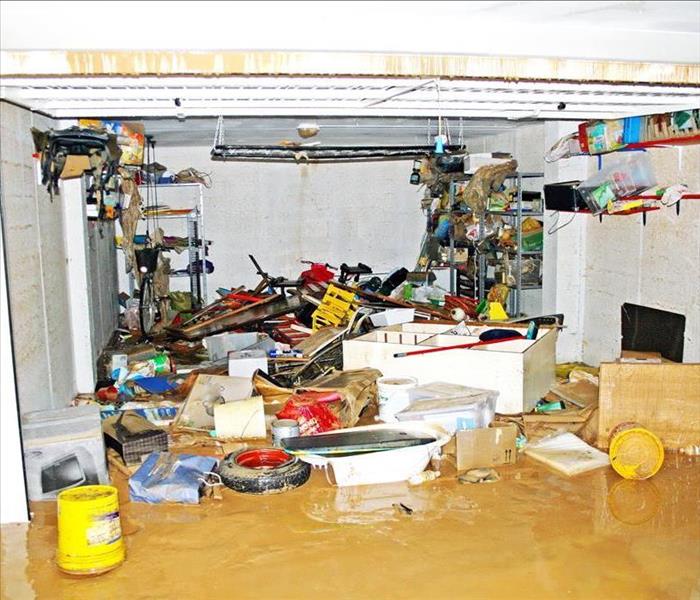 If you have a wet basement, the root cause may be one of several things.
If you have a wet basement, the root cause may be one of several things.
If you have a wet basement, the root cause may be one of several things. Before you buy new appliances or carpets, check out the possible causes of your basement flooding and learn how to fix them.
Faulty Sump Pumps
Foundations can be damaged by a variety of factors, such as erosion, shifting soil, and water damage. When a foundation is damaged, it may not be able to provide proper drainage for the home anymore. This will lead to water pooling in low-lying areas such as the basement or crawl space.
In addition to improper drainage systems, another common source of basement flooding is faulty sump pumps. A sump pump is a device that pumps water away from buildings through pipes leading to an area outside of your property. Sump pumps are used in basements or other low-lying areas where groundwater may accumulate
because they are often located below ground level with little natural drainage. They are also commonly used as part of a larger system designed for rainwater runoff removal from houses with flat roofs or when other sources of flooding occur within homes (e.g., broken-down appliances).
Foundation Leaks
One of the most common causes of basement flooding is foundation leaks. Foundation leaks can occur when there are cracks in your home's foundation, which means that water has access to your basement. This often results in wet carpeting, flooring, and wall insulation. You should look out for these signs:
- Watermarks on walls
- Water stains on ceilings
- Wet carpeting or flooring
A professional inspection will help determine if you need a repair or replacement of any damaged areas of your home's foundation. If you have a small crack that you're able to seal yourself, make sure to use materials specifically made for waterproofing purposes; otherwise, the problem could get worse over time as moisture gets inside through other openings (like windows).
Heavy Rain and Storms
Clogged runoff drains are one of the most common causes of basement flooding in homes across the country. To help prevent this, make sure your gutters are clear at all times! If they're not, water can back up into them during heavy rains causing damage to your foundation walls by seeping through cracks in the siding or through cracks in the foundation wall. If you don't know how often you should clean out these drain pipes then check with a professional before cleaning yourself out because sometimes rainwater can end up being too powerful for homeowners without proper training (or experience).
If you have a wet basement, it’s important to find the cause before it gets worse. Basement flooding can be caused by all sorts of things, from faulty sump pumps or foundation leaks to heavy rain or storms. If you suspect that your Montclair home is experiencing flooding due to one of these issues, contact a SERVPRO of Montclair/West Orange.
Signs You Need Water Damage Restoration Services
12/5/2022 (Permalink)
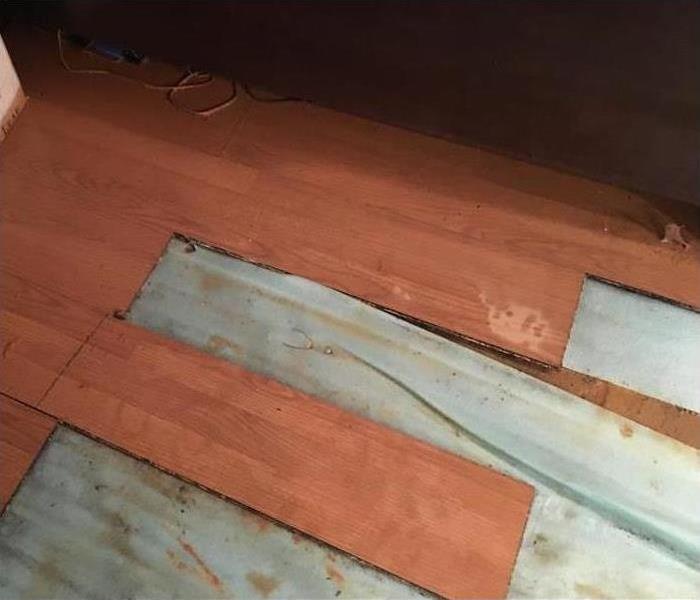 Removing flooring to remove moisture
Removing flooring to remove moisture
Signs That Water Damage Restoration Services Are Required
Water damage is a serious issue, and if you don't get it fixed as soon as possible, it could cause lasting damage to your Montclair, NJ home or business. Here are some signs that you need water damage restoration services:
Wet Spots on the Floor or Ceiling
Leaks are a common cause of water damage, so look for signs of them. If you have a leak, you may notice wet spots on the floor or ceiling. Check for watermarks on your ceiling and look for moisture under sinks and toilets. If you see any of these signs, it's time to call in an expert!
Significant Changes in Your Water Bill
If your water bill has increased, that can be a good sign that you have a leak. The increase will usually happen over time and not all at once. So if you notice an increase in your water usage and there are no changes to the number of people living in your home or anything like that, it could be because of a leak.
Test Your Carpets
Carpets can be a good place to start because they are the most susceptible to water damage. To test your carpets and floors, you can use a moisture meter. This little device measures the amount of moisture in the flooring material and will tell you if it is wet or if it has been damaged. If your carpet does not pass this test, get some help from an expert who can remove as much of the water as possible before it causes permanent damage to your home.
Listen and Watch the Dishwasher
If you hear the dishwasher running longer than usual, check it for leaks. Look at any water on the floor around your sink or underneath it and see if there are any leaks that are causing this.
If a leak is suspected, turn off the water supply under your sink immediately to keep from causing even more damage by flooding the area further.
Check Under Your Sinks
Many of us take daily showers and are accustomed to seeing some discoloration on our bathtub liner. However, if you notice any rust or mold under your sinks, it could be a sign that there is more water damage than meets the eye. It's important not to touch anything that might be contaminated because this can spread bacteria throughout the home.
Call the Professionals
It’s important to know that the faster you call SERVPRO of Montclair/ West Orange to investigate, the faster we can get you back on track. We will help assess the damage and make recommendations for cleanup and restoration services to begin as soon as possible.
In short, water damage can be a disaster if left to go unchecked. If you have any of the signs above, call SERVPRO of Montclair/ West Orange immediately to investigate and get the problem taken care of before it becomes worse. Our trained professionals will help you assess the damage, formulate a plan for restoration, and get it done quickly!
Is It Necessary To Replace My Carpet?
11/8/2022 (Permalink)
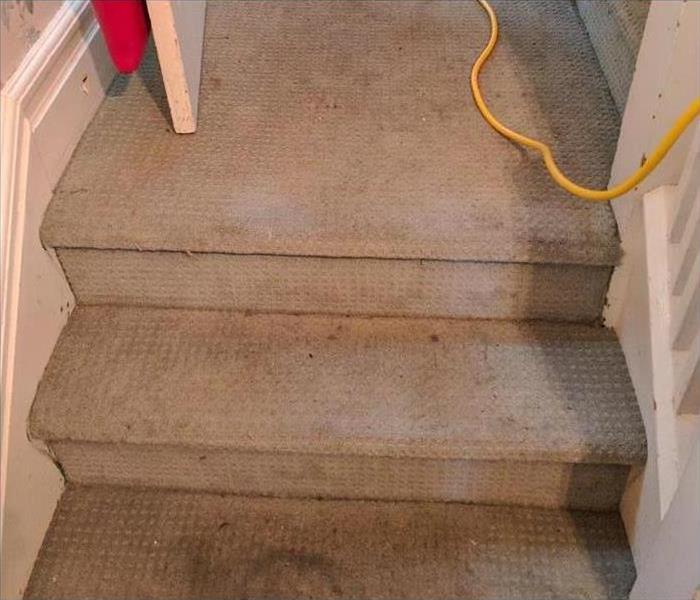 Carpet water damage
Carpet water damage
Do I Need to Replace My Water-Damaged Carpet?
If you’re like most people, you have dealt with flooding in some capacity before. You might’ve had to deal with it in your own Montclair, NJ home. If so, you might have asked yourself whether or not it's necessary to replace your carpet if it gets wet.
We get this question all the time at SERVPRO of Montclair/West Orange. In most cases, though, replacing your carpet is not necessary if your water was clean—that is, it hasn't been contaminated by sewage or chemicals or other contaminants that could damage it over time. The first step in determining whether or not replacing your carpet is necessary depends on how much water was involved and how long it stood there before being cleaned up or dried out completely.
Act Quickly
It is important to act quickly and get the standing water cleaned up. Once you've removed as much water as possible, it is time to prevent mold growth on your carpet. The first step for preventing mold growth is to use a wet vac or towel to extract any remaining water from your carpet. If you don't have a wet vac available, make sure that the room where you are cleaning has good ventilation so that any moisture in the air can evaporate quickly enough before releasing its moisture onto your carpet fibers.
Once all of the standing liquid has been extracted from your carpet, use an anti-fungal agent to cleanse and sanitize both sides of each fiber in order to kill off any potential microscopic organisms living there.
Extract Water
You will want to extract as much water as possible as well. If you have access to a professional steam cleaner, this is definitely your best option. But if you don't have that luxury, you can use a wet vac or shop vac, carpet cleaner and/or even professional services such as SERVPRO of Montclair/ West Orange.
If the liquid that made your carpet wet was dirty or harmful in any way—for example, an overflowing sewer system—you should replace it since these contaminants will cause permanent damage if they are not removed properly. Your best bet is to call the experts at SERVPRO.
If your carpet is wet, you do not need to replace it as long as the water was clean. The key to this is acting quickly! If you are able to extract all of the standing water and get rid of any debris that may have gotten into the fibers, your carpet should be fine. It might take some time for the carpet to dry out completely, but once it does, you will be left with a soft and fluffy surface!
Leave Puffback Soot Cleaning to the Professionals
10/11/2022 (Permalink)
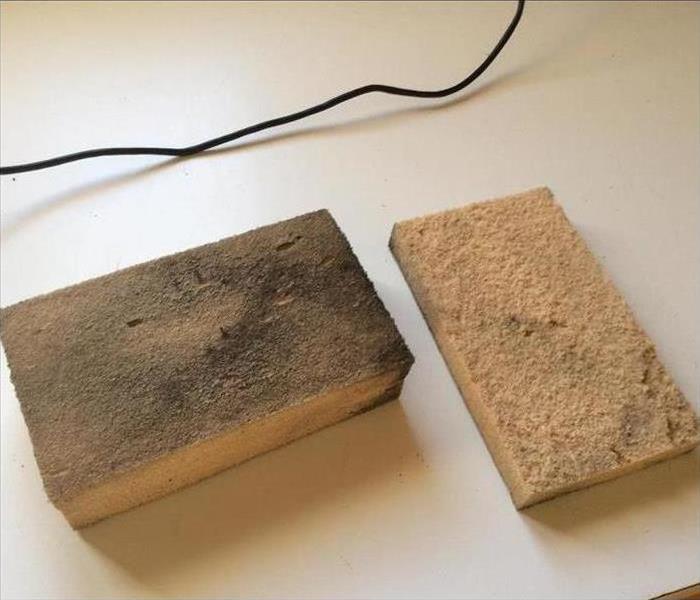 Don't clean puffback soot yourself
Don't clean puffback soot yourself
When you are cleaning your home, you want to make sure that the job is done right. You want to make sure that you do not miss anything or do anything incorrectly. You may even consider doing some of the work yourself and saving some money in the process. However, there are times when it is better to leave a task up to someone else who has more experience than you do. Such is the case with puffback soot damage on walls: if left unaddressed, this damage could spread easily through your home and into other rooms and areas of your home over time.
What is Puffback?
Puffback occurs when the oil burner is not operating properly. It can cause damage to your walls and is potentially dangerous if you attempt to clean it yourself. Your best course of action if you are experiencing puffback is to contact your local HVAC professional, who will be able to inspect the system and make any necessary repairs.
Cleaning Puffback Damage
If you’re dealing with a puffback soot stain in your home, there are several steps you can take to clean up and remove the mess. First, use a damp cloth to wipe away any loose particles of soot that may be hanging around on your walls. Then, vacuum the area thoroughly with a vacuum hose attachment to get rid of any remaining particles and dust.
Next, wash the walls with a mild detergent diluted in water—this will not only clean off any remaining soot but also restore their original color! To dry them off after cleaning: wring out excess moisture from a soft cloth then use this cloth to gently pat down each wall until it’s dry (or nearly dry). Finally, if it seems like there are still remnants left behind after washing or drying—even after vacuuming—you might want to call in professionals for an inspection.
Of course, the better option is to call the professionals at SERVPRO of Montclair/West Orange to handle the entire process from start to finish.
Cleaning Puffback Smoke is Dangerous
Not only is it dangerous and unhealthy to clean puffback soot yourself, but it can also be bad for your home. When you do the work yourself, you risk damaging your walls and other surfaces. In addition, if you don't have experience cleaning soot from the ductwork of your furnace or fireplace, then there's a chance that you'll accidentally damage the unit itself. For example: Some models of furnaces require a certain type of filter called an electrostatic filter or electronic filter in order to operate properly or at all. If this filter is damaged during dusting or vacuuming (for example), then it won't function correctly anymore. That means that this part needs replacing—and that costs money!
As you can see, puffback soot is not something to play around with. You do not want to risk your health and safety by cleaning the walls yourself. It is best to hire an expert who will know how to handle this dangerous substance properly, so they can ensure your family’s safety and property remain undamaged during cleanup.
5 Guidelines for Avoiding Cigarette Fires at Home
8/30/2022 (Permalink)
 Those who use medical oxygen or those who store it should keep lit cigarettes away from them.
Those who use medical oxygen or those who store it should keep lit cigarettes away from them.
5 Tips For Preventing Home Cigarette Fires
Smoking poses a threat to your home in Verona, NJ when you have improper habits. Following these five guidelines will protect you from any potential cigarette fire.
1. Use an Appropriate Container
An ashtray with a wide base or bucket full of sand should be around in areas where you typically smoke. When using an ashtray, it should be stable on a surface to prevent accidental knockdowns. Keeping it stable prevents it from spilling and starting an ashtray fire from a still-smoldering cigarette.
If possible, the container should also be kept away from any building to add distance between the flame remnant and all flammable structures.
2. Completely Put Out Cigarettes
When you are finished smoking, it’s advised to add water to the ashes and cigarette butt to completely remove the fire and its risks. If you ever have to step away or need to stop smoking, you should put out your cigarette to avoid leaving a lit one unattended.
3. Smoke Only When Fully Awake
If you are taking medicine that makes you drowsy or sleep deprived, it is best to avoid smoking. If you pass out while smoking, you will likely drop your cigarette. Since you are asleep, you will also have a harder time escaping or stopping any growing cigarette fire. Smoking while sleepy puts your home at risk.
4. Only Smoke Outside Your Home
There is a sizable difference in the number of flammable objects when comparing a typical indoor and outdoor environment. Your furniture, curtains, trash bin, mattress, and bedding can all be ignited by a loose cigarette. It is much safer to smoke outside and remain there until you are finished.
5. Avoid Smoking Around Oxygen Tanks
Oxygen is very sensitive to fire. Lit cigarettes should be kept away from anyone using medical oxygen or places where it’s stored.
4 Tips for Removing Standing Water From Your Building
8/29/2022 (Permalink)
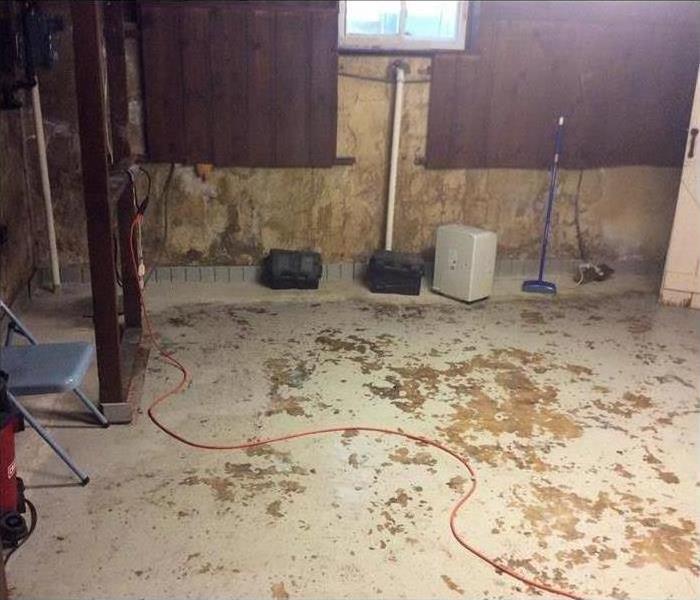 Basement flood cleanup.
Basement flood cleanup.
How Do I Remove Standing Water From My Property?
Storms in Llewellyn Park, NJ, can bring a lot of water with them. With so much excess water, it's not all that surprising when your commercial building ends up with standing water in its lower levels. Even though it is not a shock, it can still be a challenge to deal with. Working with a team that has the specialized equipment needed to remove standing water can make this entire process a little easier. Keep these four tips in mind as you try to tackle this remediation.
1. Call in the experts. Your first step should be to call in a commercial storm damage repair team. This crew of professionals can help you remove standing water, repair damage, and prevent the same flooding from happening again. The teams can also make sure the project is done quickly.
2. Consider the water. If your basement is full of plain water, you may be able to use a simple pump to suck the floods out of the space. However, if there's any sludge mixed in with the liquid, you may need to turn to a trash pump instead.
3. Remove all humidity. Once you have the standing water out of your building, the project isn't quite over. You still need to make sure all of the excess moisture is sucked from your space. Using special equipment, such as a dehumidifier, can help with this task.
4. Install a new pump. If you have a sump pump in your basement, you may need a new one after dealing with a two-foot flood. If you didn't have a pump, installing one may help you avoid more flooding in the future.
You can never predict what type of damage a storm is going to do to your commercial building. You can, however, make sure you work with a trained team that has access to a wide range of equipment if your property is affected by a storm.
Reduce Mold in Your Commercial Building's Bathroom
8/24/2022 (Permalink)
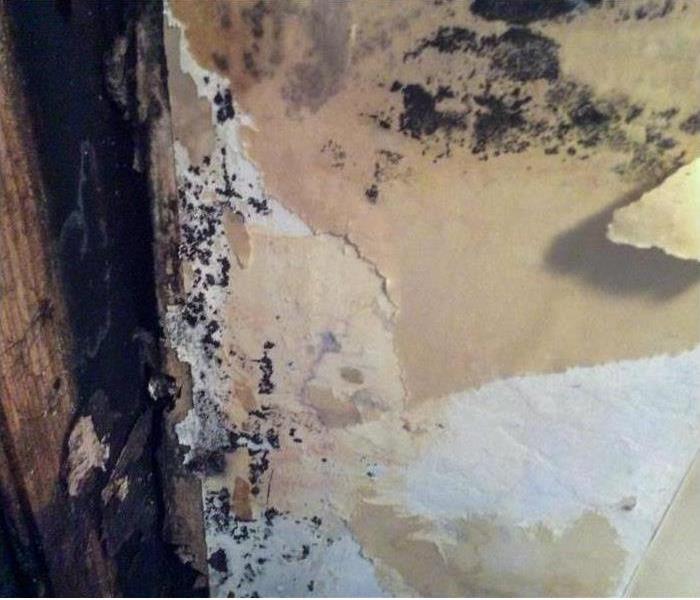 Keep the humidity as low as possible
Keep the humidity as low as possible
The bathrooms in your commercial building are one of the most common places for mold to grow. Mold spores are everywhere, but the moisture and humidity in bathrooms are an invitation for these spores to grow into a large-scale mold problem. To discourage mold growth, reduce the moisture, and conduct thorough mildew clean frequently.
How To Reduce Moisture in Bathrooms
Follow some simple steps to eliminate the accumulation of moisture in your bathrooms.
Inspect for leaks frequently. The pipes and seals attached to the sinks and toilets must be secure. If you spot a leak and your maintenance staff isn't capable of fixing the problem, contact a plumber right away.
Seal the bathroom tile's grout lines each year. After thorough mildew clean, apply a sealant to the grout lines to keep them waterproof. If the grout isn't cleaned properly beforehand, the sealant won't adhere effectively.
Keep the humidity as low as possible. Because of the humid weather in Montclair, NJ, installing a dehumidifier reduces the moisture in the air. A dehumidifier increases ventilation which discourages mold growth as well. Your air conditioner will also cool the air and remove moisture.
How To Conduct a Thorough Cleaning
Conduct proper cleaning each week to prevent bathroom mold. Dust is a food source for mold because mold spores like to settle on surfaces. Lightly dampen a cloth and wipe the counters, faucets, and door handles. After dusting, use an all-purpose cleaner to thoroughly clean each surface, including sinks, toilets, and flooring.
Clean bathroom mirrors with a glass cleaner each week as well. Spray the cleaner on a cloth and wipe the entire mirror. If any streaks remain, buff them out with a dry cloth.
Maintaining your bathrooms with thorough mildew clean and reducing excess moisture will discourage mold growth. If you are concerned about mold, contact a mold remediation specialist as soon as possible.
How Hail Can compromise Your Roof
7/28/2022 (Permalink)
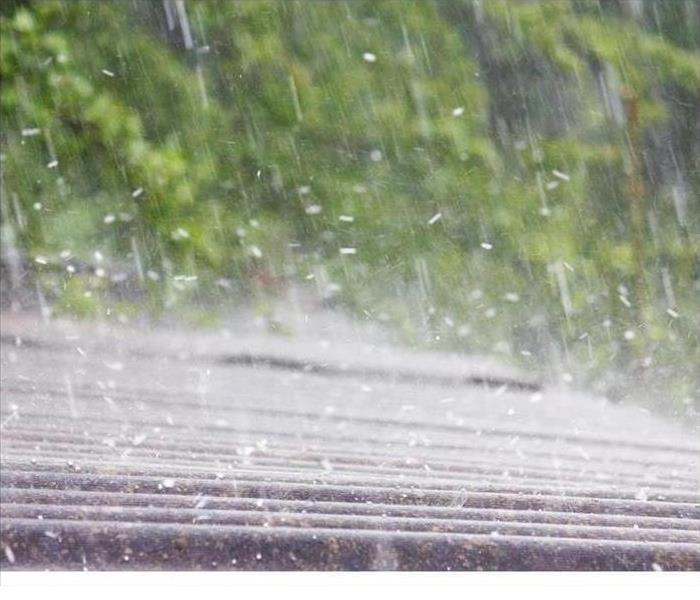 Hail storm in Llewellyn Park, NJ.
Hail storm in Llewellyn Park, NJ.
A healthy roof can protect your commercial property from storm damage in Llewellyn Park, NJ. Roof damage from a severe storm requires you to act quickly to avoid costly consequences.
How Can Hail Affect Your Roof?
Hail storms are typically not long-lasting, but they can severely compromise your roof depending upon various factors, including:
- Stone size
- Stone weight
- Stone shape
- Speed at Impact
- Roof material
Hailstones can have diameters up to three inches and weigh as much as a pound. They can form with jagged edges and travel over 100 miles per hour from thousands of feet above the ground. Damage occurs if these large stones land on your roof and puncture a hole through it.
How Can You Identify Hail Damage?
Roof damage following a hail storm is not always easy to recognize if it doesn't leave a gaping hole. Following a hail storm, it is necessary to conduct a roof inspection and look for the more subtle damage signs. Your roof may have damage if your gutters are out of place or dented or if they are not draining properly due to clogging from trapped hail particles. Dents in your building's siding following a hail storm are another good indication that your roof also has damage.
What Are the Consequences of Ignoring Roof Repairs?
Delaying roof inspections or hail damage repairs can lead to other issues affecting your building's interior. For example, a small hole in your roof can grow bigger if it remains unrepaired. As a result, water from the next rain or snowstorm could make its way inside. The result could be an obvious flood, water-soaked insulation or an accumulation of water within your building's interior walls. These scenarios can lead to secondary mold damage that would require immediate attention from a mold remediation service to decontaminate your premises.
If roof damage causes flooding at your building in Llewellyn Park, NJ, a disaster recovery service can undertake proper cleanup and sanitization.
How To Ensure a Fire Sprinkler System Is in Good Shape
7/12/2022 (Permalink)
 A fire sprinkler system is a vital piece of fire prevention for your company
A fire sprinkler system is a vital piece of fire prevention for your company
How to Check the Condition of a Fire Sprinkler System
A fire sprinkler system is a vital piece of fire prevention for your company. The goal of a sprinkler system is to save lives from fire and to reduce property loss. As with most modern technology, sprinklers are finely calibrated and engineered mechanisms. They activate when sensors detect heat or smoke. Water-based systems then spray water onto the incipient fire and, if all goes well, douse the flames. For the system to work properly, all of its many components need to be in good shape and operational. The NFPA 25 document provides the standards for the maintenance and inspection of fire sprinkler systems, fire pumps, and standpipe systems.
Quality Fire Suppression
Few devices offer better fire protection than a sprinkler system installed in your company in Glen Ridge, NJ. They must be designed, installed, and maintained to a high standard. An inspection should be conducted at regular intervals by knowledgeable personnel and should include the following components:
- Gauges
- Pipes and fittings
- Sprinkler heads
- Valves
- Connections
- Switches
Equipment should also be tested on a regular basis. If any irregularities are found, they should be fixed or the component should be replaced. Inspections and tests are also a good time to repair any errors from the installation process. A quality maintenance program ensures the integrity of the system and makes sure it will work as intended in an emergency.
Professional Fire Mitigation
Even a brief fire in your building can produce significant damage. A local fire remediation company can arrive on your property in less than four hours and begin the restoration process. If the sprinkler system went off, the technicians will begin a fire sprinkler cleanup. This involves removing the water from the building and drying out the property and the contents. If the fire sprinkler system worked as intended, the building is likely to have suffered very little fire damage. However, smoke and soot damage may still need to be cleaned up.
4 Tools That Can Help You Clear Your Clogged Drains
7/1/2022 (Permalink)
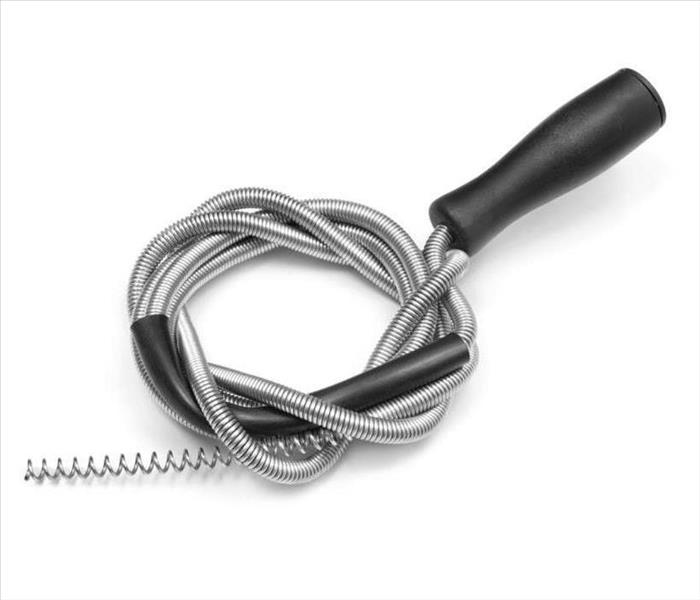 Clogs can happen in any pipe. When this happens, you must act quickly to avoid a pipe break, which will necessitate hiring a water restoration company
Clogs can happen in any pipe. When this happens, you must act quickly to avoid a pipe break, which will necessitate hiring a water restoration company
4 Tools That Can Assist You In Unclogging Clogged Drains
Any pipe can become clogged. When this happens, you need to act fast to avoid a pipe break that will require you to hire a water restoration company. Your first option is going to be to hire a plumber. However, this can be costly and inconvenient. Fortunately, there are a few DIY options when it comes to dislodging clogs. You will need to get the right tool for the job.
1. Plunger
The first tool most DIYers reach for to remedy clogged pipes is a plunger. These will remove clogs found in sinks, tubs, toilets, and more. You probably already have one of these in your home for emergencies.
2. Cable Auger
If you can't clear your clogged pipe with a plunger, the debris is probably a good distance into the pipe, and you will need to invest in a cable auger, also known as a drain snake. Any hardware store in West Orange, NJ, should have a range of snake options from 25 feet to 100 feet long.
3. Closet Auger
A closet auger is a snake that is specifically made for toilets. It will still come with a crank to help you work the tip down the toilet, but the cable will be housed in a shaft rather than a coiled spool. Also, the manufacturer will shape the tip so you can easily work it through the kinks in your toilet.
4. Electric Auger
Cloggs that are really far in your pipe or ultra-stubborn, you may want an electric auger. This machine will cut through any clog, even tough tree roots. Before using this, make sure you understand how to extend the cable and reel it back in safely.
Whether you can clear your stopped drain with a plunger or need the power of an electric auger, this DIY task is a great one to know. It can save you the time and money it would take to hire a plumber and help you keep your pipes clear.
How SERVPRO Headquarters Helps Its Franchises During Large Storms
6/22/2022 (Permalink)
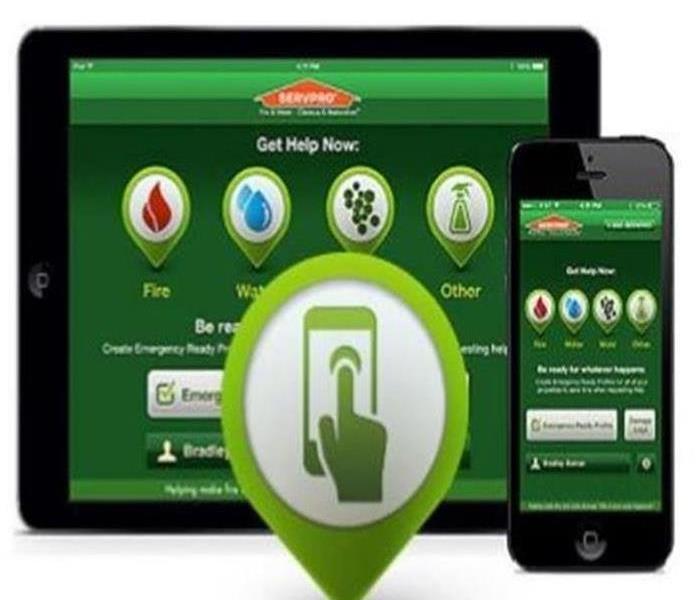 SERVPRO works with businesses to design an Emergency Ready Plan that helps limit the damage caused by heavy rain and flooding.
SERVPRO works with businesses to design an Emergency Ready Plan that helps limit the damage caused by heavy rain and flooding.
SERVPRO Headquarters Assists Franchises During Major Storms
When severe weather damages office buildings, healthcare facilities, and centers of higher learning in Glen Ridge, NJ, these organizations need assistance quickly. Fortunately, SERVPRO’S headquarters can position Disaster Recovery Teams across the United States and Canada. Here is how SERVPRO’S corporate office helps their local franchises during large storms.
Create an Emergency Ready Plan
The best way to prepare for a large-loss event is to have a plan. SERVPRO works with businesses to design an Emergency Ready Plan that helps limit the damage caused by heavy rain and flooding. SERVPRO’S goal is to minimize the time that companies cannot operate.
Manage Storm Response
Once the call comes into their centralized Customer Care Center, SERVPRO coordinates restoration projects for large institutions through their Commercial Large Loss Division. These professionals draw upon resources including:
- Network of 1900 locations
- Local Program Manager backed by SERVPRO headquarters
- Highly trained restoration technicians
Assemble Disaster Recovery Teams
Because of their extensive network, SERVPRO can organize restoration resources and specially trained personnel to assist with large-loss storm events from multiple franchises. This capability means that SERVPRO locations from as close as across town to as far as the next state can contribute supplies and equipment, which magnifies their effectiveness and reach.
Address Storm Damage
Thanks to SERVPRO’S preplanning relationships and strategic marshaling of equipment, certified restoration technicians can get right to work on water-related disasters. These professionals waste no time placing tarps over openings in roofs and stacking sandbags to block rising water. To salvage and restore interiors, the technicians set large fans around the property to dry out soaked furniture and prevent mold growth.
Large organizations benefit from creating an Emergency Ready Plan to be prepared for a weather emergency. SERVPRO corporate can then quickly assemble and deploy Disaster Recovery Teams from its franchises to respond to severe storm or flooding events.
How SERVPRO Professionals Clean Damaged Documents
6/8/2022 (Permalink)
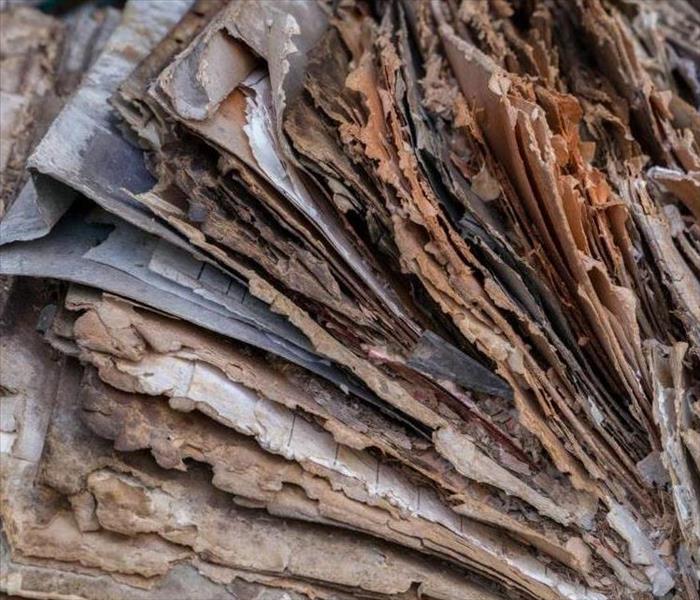 Call an experienced and skilled specialist in your Montclair, NJ area if you need to salvage papers that have been destroyed.
Call an experienced and skilled specialist in your Montclair, NJ area if you need to salvage papers that have been destroyed.
How Do SERVPRO Professionals Clean Documents That Have Been Damaged?
Whether from a fire or flood, many items in your Montclair, NJ, workplace are susceptible to damage. Many of these are highly sensitive, delicate, and important. If you want to salvage them and be able to use them again, you need to use an effective document restoration process. The good news is that highly trained and skilled professionals are available to restore even heavily damaged items.
1. A Quick Response and Assessment
When it comes to document restoration, time is of the essence. You can't afford to let water, ash, smoke, or soot sit on your documents for long. Restoration companies will respond quickly to your call, usually within the first 24 hours. The team will inspect the extent and type of damage your items have suffered.
2. Vacuum Freeze Document Drying
A common technique that technicians will use involves vacuum freeze-drying. This same technique is common in archive centers and with the most fragile documents. By doing this method of drying, technicians can safely remove any moisture on books, maps, files, and other critical materials.
3. Gamma Irradiation
Some disasters will expose documents to bacteria and harmful chemicals. To clean documents that have such contact, gamma irradiation is an effective treatment. SERVPRO technicians will sterilize the documents to reduce the risk of exposure and further damage.
4. Digitization
You work in an age where just about all records are digital. If you do not have digital backups of your files and paperwork, now is the right time to do so. This way, if a fire, flood, or other emergency damages or destroys your documents, you can still access them. This can also save storage space and give you peace of mind.
Document restoration can spare your business stress and grief. When you hire an experienced restoration company, it will use these techniques to save your materials.
Why Mold Keeps Coming Back and What To Do About It
6/1/2022 (Permalink)
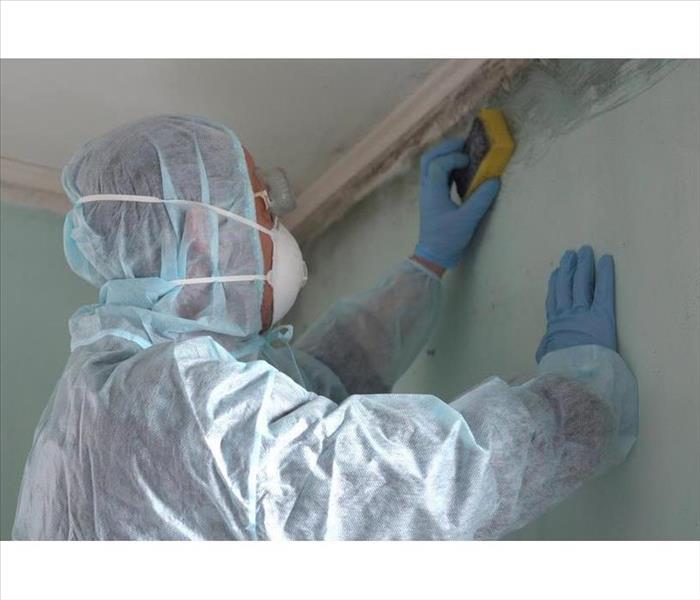 SERVPRO has a team certified to handle mold of all colors. We have the right equipment to clean it up, call us.
SERVPRO has a team certified to handle mold of all colors. We have the right equipment to clean it up, call us.
What Causes Mold Recurrence And What You Can Do About It
The second you discovered mold growth under a potted plant in the corner of the office, you jumped into action. You removed the plant, deep cleaned the area, and replaced the carpet. But a few months later, you noticed a mildew smell in the same spot. The mold is back! Repeat efforts gained the same result—returning mold. Now what?
Reasons Mold Returns
Mold is everywhere—indoors and outdoors. Spores settle in places where there is high humidity and moisture. If mold continues to return to the same spot, it is likely a sign of a leak or more extensive water damage than you previously realized. Although you replaced the carpet under the plant, the subfloor could be holding moisture. There could also be a leaking pipe behind the wall near the plant where mold is happily continuing to grow.
How To Prevent Mold Regrowth
Long-term mold prevention might require some effort and expense up front. The most important thing to know is that mold is very difficult to clean entirely without the proper training and tools. Therefore, the very best option for getting ahead of mold growth is to call a commercial mold damage specialist in Upper Montclair, NJ to come and evaluate your building:
- Evaluation: The professionals will use special tools, such as thermal imaging cameras, to look for potential leaks behind the walls.
- Containment: They will seal off the affected area and clean thoroughly.
- Removal: Any damaged materials will be securely removed from the premises to prevent the spread of mold spores.
- Restoration: Areas that have damage will be completely restored. This could be as simple as new dry wall after fixing a leak, or a more extensive reconstruction of an area that is susceptible to continued water damage.
Battling mold growth, whether in a small area or a large one, is a big job that is best left to the professionals for the long-term benefit of your business.
Special Techniques That Aid Recovery After a Storm
5/1/2022 (Permalink)
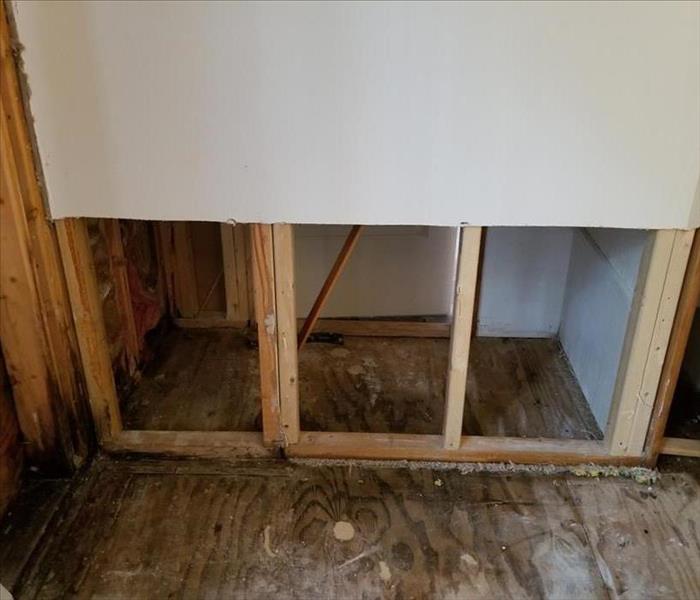 With industry-leading techniques and advanced equipment, SERVPRO professionals can quickly and efficiently restore your building after a flood.
With industry-leading techniques and advanced equipment, SERVPRO professionals can quickly and efficiently restore your building after a flood.
Special Techniques For Post-Storm Recovery
While your commercial building in Montclair NJ, might seem indestructible, in reality, it is at risk of powerful storms. Thunderstorms unleash lightning and high winds, while tornadoes produce winds of more than 100 miles per hour. As recent events have shown, hail storms can be truly destructive. Hurricanes often generate torrential rains that lead to flooding. All of these weather events put your facility at risk of damage. Fortunately, an experienced storm remediation company has the equipment and the knowledge to bring your company back from disaster. They often use specialized techniques during the restoration phase.
The Execution of a Tear Out
When water inundates your building, many materials become saturated with moisture. In some cases, normal drying is not sufficient, and a technique known as a flood cut is employed for repairing drywall and wall insulation. In the aftermath of flooding, technicians will perform the following actions:
- Remove all standing water
- Cut the drywall 12 inches above the flood line
- Remove all damaged wall insulation
- Completely dry out the area with fans
- Replace new insulation and drywall
This must be done to remove any contamination caused by floodwaters. It ensures the drywall and insulation will not later produce unpleasant odors or result in mold growth.
The Utilization of Professional Cleaning Methods
A professional restoration company will also use many different methods of cleaning and sanitizing areas of a building as well as the contents of a building. While some items such as clothes might need dry cleaning techniques, other items such as non-porous items can benefit from abrasive cleaning or foam cleaning. The technicians will determine the best method of cleaning for each item, and they will use a restore versus replace mentality when possible.
The recovery of your facility from flooding is a complicated process. Trained professionals can restore your building quickly and efficiently with industry-leading techniques and advanced equipment.
How to Handle Damaged Electronics After a Fire
4/30/2022 (Permalink)
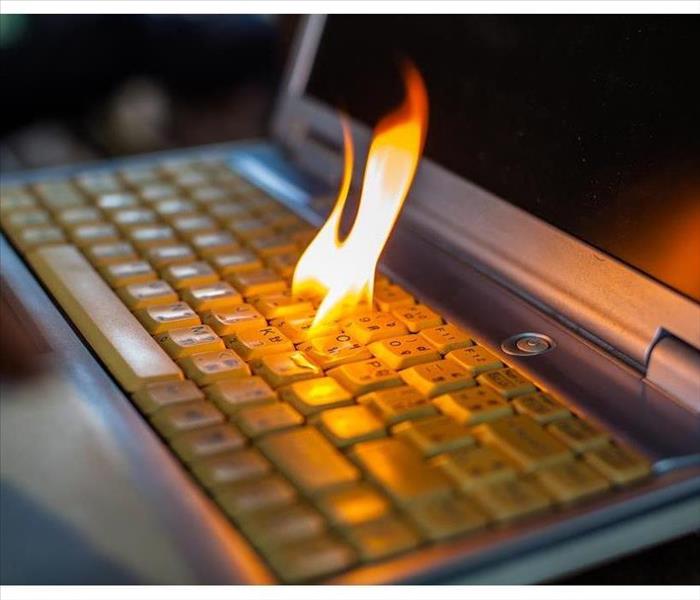 Cleaning up after a fire is a critical step in the restoration process. Many of your belongings can be saved if you treat them properly after a fire.
Cleaning up after a fire is a critical step in the restoration process. Many of your belongings can be saved if you treat them properly after a fire.
How To Deal With Damaged Electronics Following A Fire
A fire in your house in Verona, NJ, can have a large impact on your property. Not only is the building affected, but the belongings inside are often damaged as well. Even if the flames do not touch these items, smoke can cause problems, particularly for electronics. The following are some steps you can take to salvage these important devices during fire cleanup.
1. Unplug or Turn Off Your Devices
If any of your electronics are still on, turn them off if it is safe to do so. If smoke has gone inside of these objects, it can carry soot and contaminants throughout the devices. Heat and air circulation can make it easier for corrosion and permanent damage to occur if they are still on.
2. Clean the Exterior
While smoke damage can be more devastating to the inside of your devices, you should still take care to remove any residue from the outside. A wet rag is often enough for the exterior of objects with hard surfaces.
3. Drain Wet Electronics
If the fire was severe, then a hose was likely used to put out the flames. In this case, a cleanup and restoration service will need to remove water from the building before fire cleanup begins. Affected devices should be drained and dried as quickly and thoroughly as possible.
4. Have Them Inspected and Repaired
Whether they have been affected by water or smoke, your devices can be irreparably damaged if you attempt to use them before these elements have been completely removed. It is best to bring them to a professional for an inspection and any necessary repairs to make sure they are safe to use.
Fire cleanup is an important step in the restoration process. Many of your belongings can be salvaged after a fire, if they are treated in the right way. With the help of professionals, you can have your electronics ready for use again in no time.
When Flushing Your Toilet Leaves Water on the Floor
4/26/2022 (Permalink)
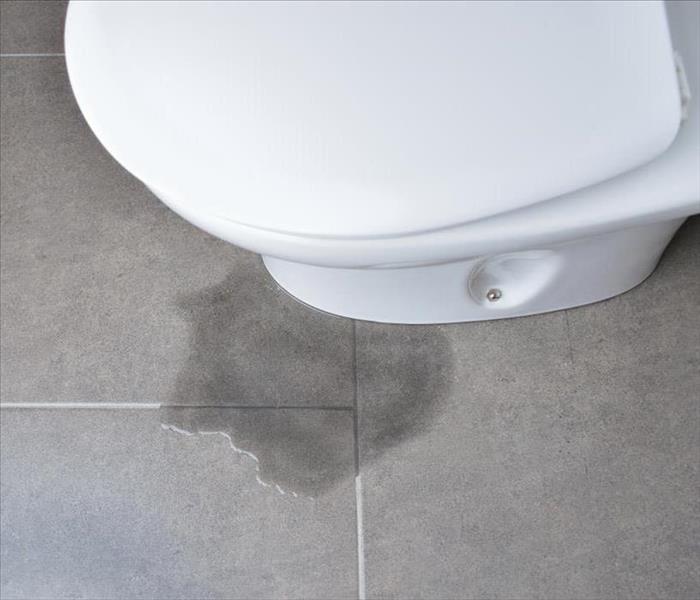 Contact SERVPRO to determine the cause of your toilet leak, make any necessary repairs, and help prevent further problems.
Contact SERVPRO to determine the cause of your toilet leak, make any necessary repairs, and help prevent further problems.
When Flushing The Toilet, Water Remains On The Floor
No one wants to flush the toilet, only to find water leaking out onto the floor around it. In most cases, however, a leaking toilet isn't cause for alarm and is usually an easy fix. All you need to do is figure out what's causing it and take steps to remedy the problem. Here's what to look for:
Take a Look at the Wax Seal
At the base of the toilet is a wax gasket that creates a seal between the toilet and the floor. Normally, when the seal is tight, the water flows straight down into the pipe when you flush. However, if the wax dries out and becomes brittle, it can develop cracks or pull away from one or both surfaces, allowing water to escape out from under the toilet base. If that's the case, it's as simple as replacing the old gasket with a new one.
Make Sure the Tank is Tight
If the toilet tank isn't on there tight, water can escape from the juncture where the tank meets the bowl of the leaking toilet. Try wiggling it — the tank shouldn't move. If it does, it needs to be tightened. Turn off the water supply and empty the tank as much as possible. Then, tighten the bolts inside to secure the tank firmly to the bowl.
Check the Tank Flange
The flange is the mechanism inside the tank that allows the water to fill and empty into the toilet. If the arm piece is broken, you can use a repair strap to fix it, or, in the worst-case scenario, replace the mechanism altogether. It should go without saying, but don't do anything to address your bathroom leak without shutting off the water supply first. If the steps outlined above aren't causing your leaking toilet, it's a good idea to call in professionals to fix the problem.
Contact a plumber or a water damage specialist in Upper Montclair, NJ, to determine the cause, make the repairs necessary and help you prevent any further issues.
5 Ways To Protect Your Business From Flood Damage
4/18/2022 (Permalink)
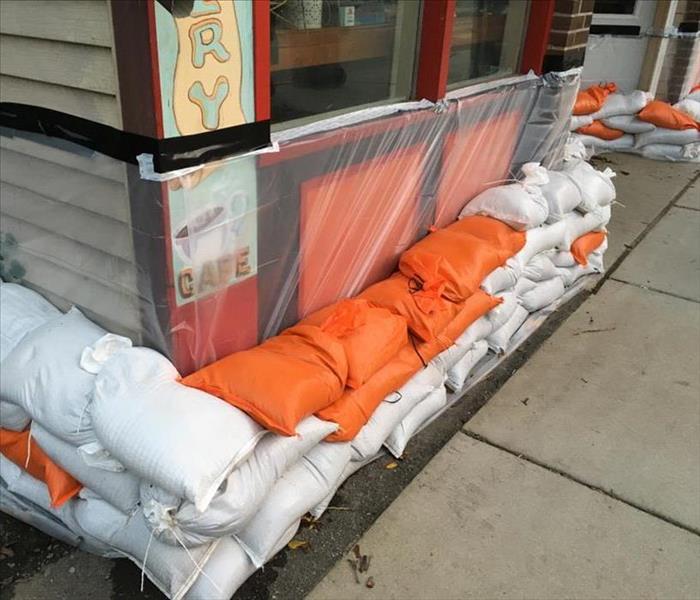 Owners have the power to minimize flood damage, but it requires forward-thinking and proactive approaches.
Owners have the power to minimize flood damage, but it requires forward-thinking and proactive approaches.
5 Ways To Prevent Flood Damage To Your Business
Commercial owners in Montclair NJ, do not have the ability to stop Mother Nature's rising waters; however, proprietors do have the authority to fight off flood damage. By taking time to evaluate the property, it's possible to minimize harm. The following are five ways to take action now.
1. Raise the Electrical Outlets
When inclement weather occurs, moisture could infiltrate the building from the roof and through the floor. This storm damage exposes electrical wiring to fluid. To avoid this contamination and the cost of fixing an entire electrical system, consider relocating outlets and major wiring systems to a higher location. Floods can rise use to several feet. Place these openings further up, at least 12 inches above the base flood elevation zone.
2. Invest in Barrier Protection
The incoming water is hard to fight off unless the perimeter has been protected with a watertight product. Keep a supply of sandbags or flood-protective material on hand. Line these around the weaker areas, especially doors and windows. Ensure they are at least 3 feet or more depending on the establishment's placement in the flood zone.
3. Safeguard the HVAC Unit
A ruined HVAC unit is expensive to replace, and it's one of the objects likely to incur flood damage if it sits on the ground at a low level. Move it to the roof or a higher floor.
4. Enhance Landscaping
Ward off flooding by planting flowers and shrubs along the business's perimeter. Use local greenery that thrives in the area's soil. The roots assist in maintaining appropriate soil levels and easing drainage issues.
5. Have a Generator
The sooner a water and flood restoration company begins cleanup efforts, the better. A generator allows for workers to get into the place faster and begin drying out the soaked material.
Owners have the power to minimize flood damage, but it requires forward-thinking and proactive approaches. Be open to changing devices' locations and consider methods to secure the area from water infiltration. Doing these things could save time, stress and money.
3 Common Commercial Irrigation System Problems and Solutions
3/23/2022 (Permalink)
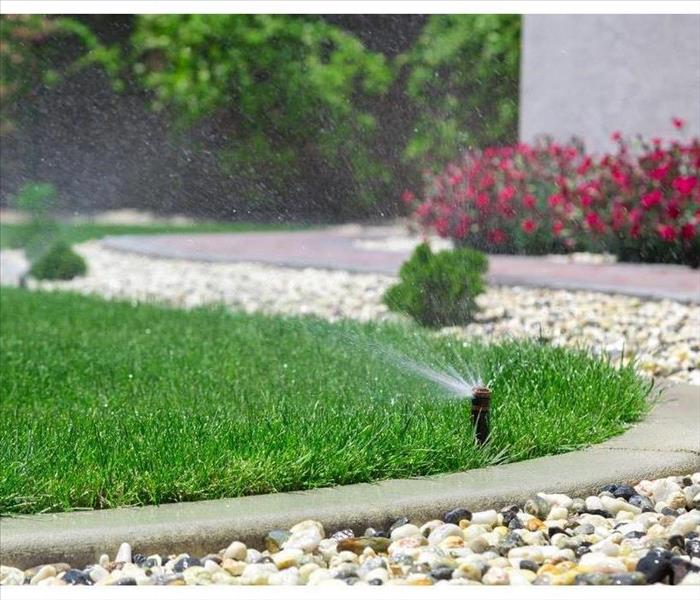 Troubleshooting an irrigation system is simple if you have some knowledge and the assurance that a professional is nearby if any water damage occurs
Troubleshooting an irrigation system is simple if you have some knowledge and the assurance that a professional is nearby if any water damage occurs
3 Issues with Commercial Irrigation Systems And Their Solutions
Has your building in West Orange, NJ, been experiencing troubles with the irrigation system? This is a frustrating experience, but there are a few common problems that comprise the majority of troubles. Luckily, these issues are solved with relative ease.
1. Low Flow in Big Areas
If your heads are barely spraying water, it is likely that you have a pressure issue. There are a few causes of this problem. First, your backflow device may be malfunctioning. Check to be sure the valves are completely open. Another more serious issue is a possible water leak somewhere along the lines. This is a huge hassle because it also leads to flooding and water damage to your property. If water damage is an issue, it's best to call in a water damage restoration specialist.
2. Individual Sprinkler Issues
If individual heads in your irrigation system are not activating, it's most likely an issue with the single sprinkler itself. This means no widespread irrigation problems, and it's usually an easy fix. Inspect the head to see if it is damaged or clogged with mud or other debris. If this is a reoccurring problem, consider lowering your heads a bit further into the ground to protect them from law care crews or foottraffic.
3. Large Areas Not Turning On
If large swaths of sprinklers aren't turning on, the culprit is probably electrical in nature. The controller needs to be inspected and checked for any obvious frayed wires, and you should also use a multimeter to check that the correct amount of voltage is flowing. Normal voltage is about 24 to 28 Volts. Sometimes only a single part needs replacing, but other times a full controller replacement is necessary. It's best to consult a technician to know for sure.
While an irrigation system may seem complicated, there are only a few issues that affect most properties.
3 Factors To Consider When Shopping for a Smoke Alarm
3/22/2022 (Permalink)
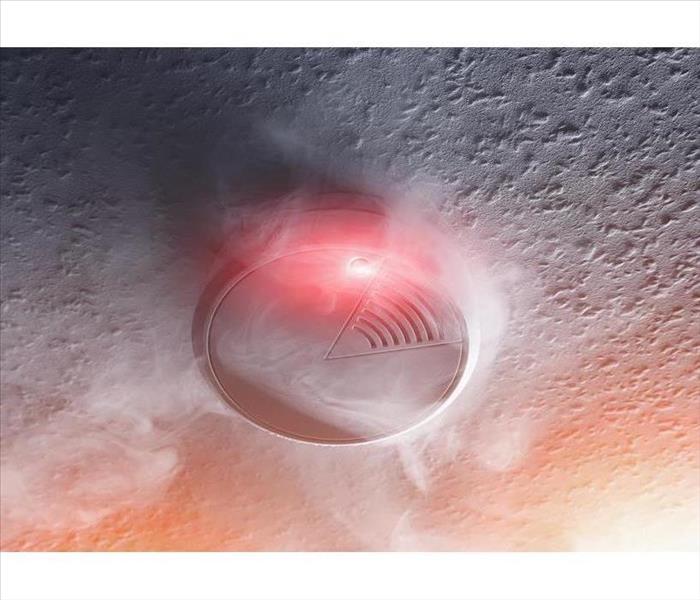 There are many different options when purchasing a smoke alarm for your home, and it is important to understand the different types and their uses.
There are many different options when purchasing a smoke alarm for your home, and it is important to understand the different types and their uses.
When Looking For A Smoke Alarm, There Are Three Things To Think About.
When it comes to home fires, knowing your home exits, how to use a fire extinguisher and how to contact a fire damage restoration service is paramount for keeping your family safe and mitigating damage. However, when it comes to safety, prevention is equally as important. Having a working smoke alarm greatly improves your chances of evacuating your home and surviving a fire in Upper Montclair, NJ. Here are a few factors to consider when purchasing an alarm.
1. House Size
If your house is large and spacious, you should consider a system that connects each individual detector together. If a unit goes off at one end of the house, it will sound all the alarms that are connected. These systems typically require professional installation since they are wired to your household electric current. Regardless of the size of your house, you should place a smoke detector in every room, hallway and stairway.
2. Sensor Type
Depending on the room you choose to place your smoke alarm, you should review the types of sensors to fit each room’s need. For example, ionization alarms are extremely sensitive, and while they are great for home use, they may not be best for your kitchen, where smoke from your stove or burnt crumbs from your toaster can accidently set off the alarm. Photoelectric sensors are not as easily triggered and work well in kitchens.
3. Testing and Maintenance
Routine testing and maintenance are extremely important when it comes to fire safety. Alarms should be cleaned and tested monthly to ensure they are working properly. Keep each unit free from dust to avoid blocking the sensors and replace batteries as needed. If the units are difficult to reach, you should invest in a system that can be tested with infrared signals.
There are many different options when purchasing a smoke alarm for your home, and it is important to understand the different types and their uses. In addition to finding the right system, making sure that you clean and test your units regularly will help keep you and your family safe if a fire does occur.
How to Remove Lingering Odors Caused by Water Damage
3/17/2022 (Permalink)
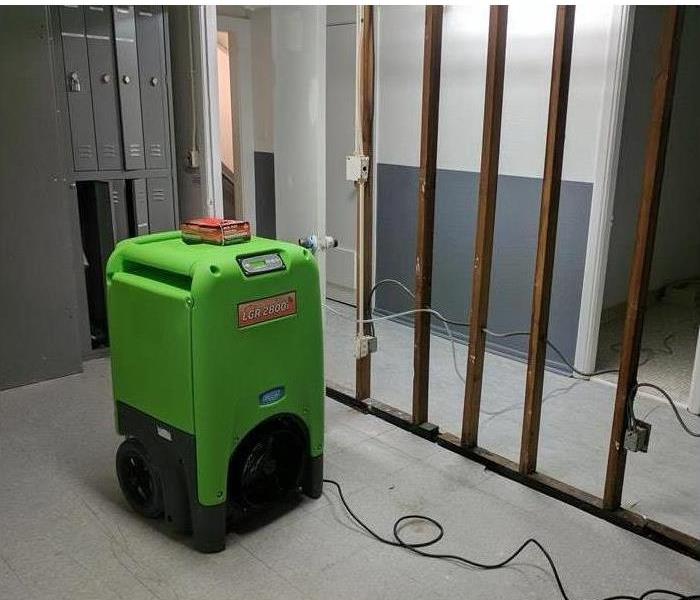 Materials like insulation and drywall can quickly absorb flood water. This is what causes scents to linger and structural damage.
Materials like insulation and drywall can quickly absorb flood water. This is what causes scents to linger and structural damage.
How To Get Rid Of Lingering Water Damage Odors
Water of all kinds can cause damage to your Montclair NJ, building. While contaminated water may be more likely to cause lingering odors, clean water can also contribute by facilitating mold growth. If you are noticing bad smells after water damage, the following steps can help remove it.
1. Clean Surfaces
Both flooding and sewage loss can bring contaminated water into your building. This can contain bacteria, mud, waste and other debris. As a result, it can carry with it unpleasant odors. Everything that this water has come into contact with should be thoroughly cleaned, both to reduce these odors as well as to prevent bacteria from spreading within the building.
2. Perform Mold Remediation
Mold spores that have been brought into the building by contaminated water, as well as those already present, will grow quickly in a wet environment. Infestations of this fungus can then create a musty odor. Both the mold growth and the smell can be effectively removed by a mold remediation company.
3. Replace Damaged Materials
Materials like insulation and drywall can easily absorb large amounts of flood water. These are not easily cleaned, resulting in bad smells that stick around as well as damage to the building. Removing and replacing these materials should reduce lingering odors.
4. Remove Odors From the Air
If you have tried the previous steps but still haven’t quite removed all of the bad smells, then you may need to clean the air inside the building. Using an air purifier, you can remove bacteria and other contaminants to create a clean and fresh-smelling environment.
After you have experienced water damage, it can take some time to return your building to its previous condition. Everything should be cleaned thoroughly and any mold growth should be removed. In most cases, it is best to have this done by a professional who has the necessary training and equipment to get the job done properly.
3 Safety Measures To Employ When Replacing a Toilet
2/8/2022 (Permalink)
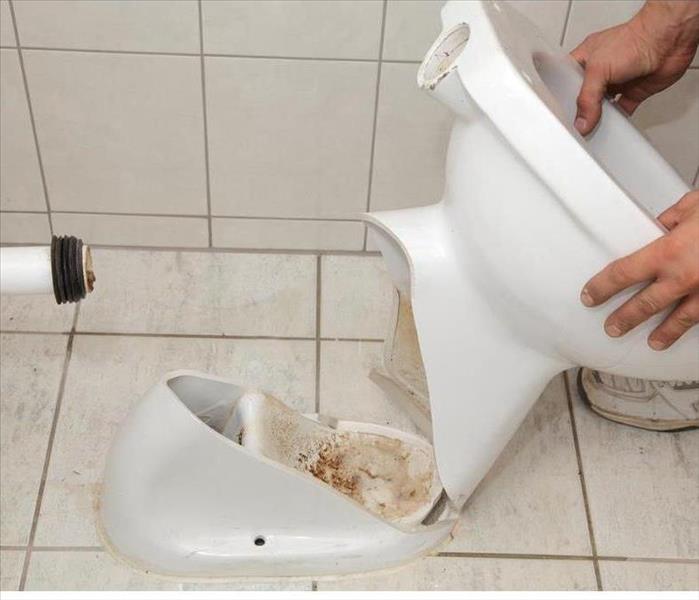 Wear gloves and protective glasses and have a bucket within arm’s reach to prevent water spills during the toilet repair.
Wear gloves and protective glasses and have a bucket within arm’s reach to prevent water spills during the toilet repair.
When Replacing A Toilet, Take These Three Precautions.
When a toilet malfunctions in your Montclair NJ, home, you will probably want to take steps to fix it right away. A leaking toilet may be especially problematic because it can damage your floors and create the perfect environment for mold growth. If you need to replace your toilet, there are a few safety measures you can put in place for each step to keep yourself and your family safe.
1. Prepare the Area
Before you remove the toilet, preparing the area can prevent accidents before they start. Keep young children and curious pets away from the bathroom and have newspapers or a tarp handy to rest the toilet on once you remove it. Wear gloves and protective glasses and have a bucket within arm’s reach to prevent water spills during the toilet repair.
2. Inventory Your Tools
Removing your old toilet requires a few tools, including a scraper, wrench, pliers and a measuring tape. Collect all these tools ahead of time so you will not have to search for them during the repair process. When you use your wrench to loosen the bolts that hold the toilet to the floor, be sure no tools are scattered around before you attempt to lift the toilet and check the wax seal and flange, as stumbling during this phase could cause serious injury.
3. Avoid Touching Contaminated Water
A leaking toilet may cause contaminated water to puddle around the base or run across your bathroom floor if it should spill from the bowl or if it has previously overflowed. If this occurs, call a flood cleanup and restoration company to inspect and sanitize your bathroom to prevent damage to your floors and walls and to check for the presence of mold before you install the new toilet.
Replacing a leaking toilet at your Montclair NJ, home does not have to be difficult when you take the time to work safely. Making the right preparations, reading through directions before you begin and taking one step at a time can help keep this a safe and painless process.
Recovering From a Home Fire Only Takes Two Phone Calls
2/8/2022 (Permalink)
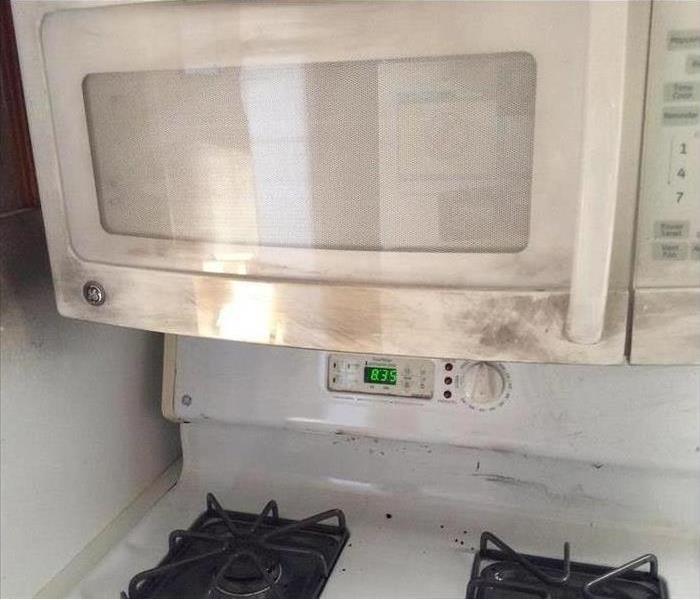 This home had a fire loss that started in the microwave. We responded quickly and were able to clean up and repair all the damage. Call us!
This home had a fire loss that started in the microwave. We responded quickly and were able to clean up and repair all the damage. Call us!
It Only Takes Two Phone Calls To Get Back On Your Feet After A House Fire
The first call is easy. Contact your insurance company and explain your situation. They will confirm your coverage and send an adjuster to assess the damage. The basis for the adjuster’s estimate is the amount of damage caused by the fire. This fire restoration estimate includes the cost of:
- Protecting your home from the wind and rain until repairs are complete.
- Removing water and eliminating water damage.
- Removing restorable items and sending them out for restoration.
- Removing damaged material for disposal.
- Removing the effects of smoke and soot on your home and its contents.
- Cleaning your home in preparation for final restoration.
- Restoring your home to its original condition.
The Rest Is Up to You
The adjuster leaves you shaking your head. In one hand, you have the estimate. In the other, you have the insurance company’s list of preferred vendors in the Upper Montclair, NJ, area. You dread the thought of:
- making all those calls
- talking to all those contractors
- scheduling all that work.
It looks like a full-time job. You don’t have that kind of time. You look at the list of preferred vendors and, suddenly, one name jumps off the paper.
Your Second Call Is Even Easier
That name belongs to a company that can do the entire job. There is no need to convince them of the urgency. They already understand that the tarps and plywood must go up immediately.
Many people don’t understand the extent of this company’s capabilities. When you excel at something, people tend to forget about your other skills. Providing rebuilding services is a natural addition to their cleaning and restoration expertise. After all, why would you bring in a separate contractor after a fire to rebuild when one can do it all? Having this company do the job is one-stop shopping at its best.
It’s Time To Make That Call
You’ve selected the best contractor from the preferred vendor list. You want the restoration to begin quickly. It’s time to make that second call. Those full-service fire remediation specialists are ready to go.
3 Things Business Owners Should Know After a Partial Loss From a Fire
1/31/2022 (Permalink)
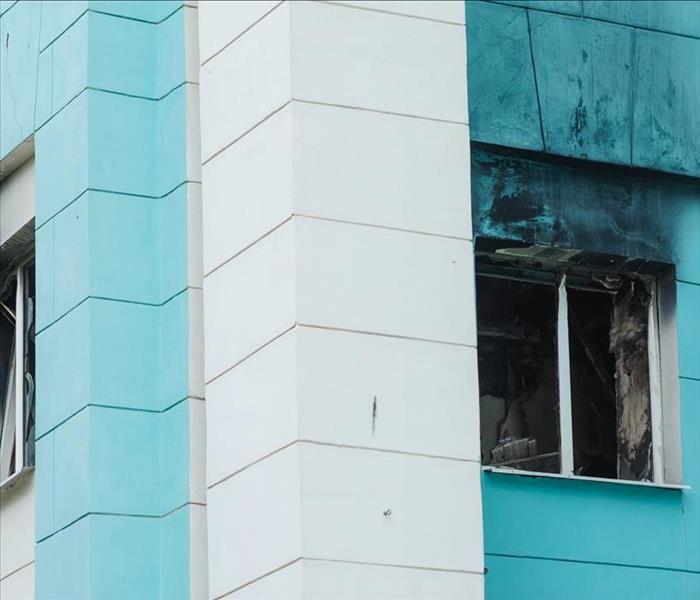 Commercial fire loss in Montclair, NJ.
Commercial fire loss in Montclair, NJ.
What To Expect After a Partial Fire Loss
A fire in Montclair, NJ, can wreak havoc on a business. Fire loss is often one of the first things business owners think about, and many people believe that a partial loss will mean a quick, inexpensive cleanup process. However, this may not be the case, and it can be helpful to know what to expect after a partial loss.
1. An Insurance Claim for Partial Loss Can Be Complex
Although you make an insurance claim after a partial loss, just as you would if fire and smoke damage had affected the entirety of your business, partial losses can make your claim more complex. It can take an extended period of time for an insurance adjuster to determine what items were damaged in the fire and what items weren't affected by the fire. Providing your adjuster with photographs and other forms of documentation of your business before the fire might help to expedite the process.
2. Unseen Damage Is Often Present
With a partial fire loss, people often think that a building has been minimally damaged. Unfortunately, there is often hidden damage associated with partial losses. During a fire, the air quality in a business is often affected by smoke and soot, and though your building's air ducts aren't visible, damage may be present. Additionally, both water and mold damage commonly occur after fires when sprinklers and fire hoses are used to extinguish the flames.
3. Restoration May Still Be Necessary
Though a partial loss from a fire means that some elements of your business are unaffected, restoration may be needed depending on what areas in your business were impacted. If structural elements of your building were damaged in a fire, restoration is often essential. Many business owners find it useful to employ fire restoration experts who can assist in cleanup and restoration.
When considering a fire loss, it's often wise to understand what a partial loss from a fire may involve. By understanding the complications that can come from a partial loss, such as difficulties with an insurance claim, unseen damage and the potential need for restoration, you can better plan for a fire and its effects.
How Does Storm Damage Differ From Flooding?
1/31/2022 (Permalink)
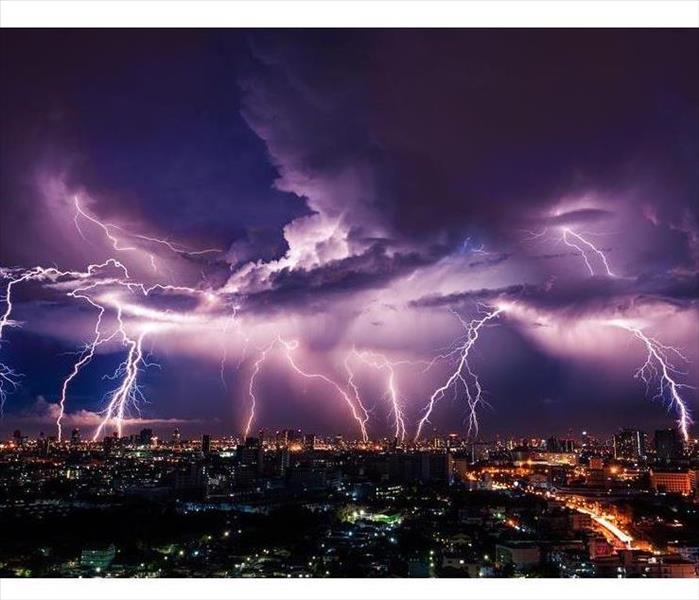 Damage resulting from either flooding or storms can cause severe problems and should be planned for, prevented, and handled as soon as possible.
Damage resulting from either flooding or storms can cause severe problems and should be planned for, prevented, and handled as soon as possible.
What Is The Difference Between Storm Damage And Flooding?
Property owners may have a hard time differentiating storm damage from flood damage. Commercial properties can sustain water damage from either source. There are a few major differences to keep in mind that may help you manage these risks.
Storms Versus Floods
The most general distinction is that storm water comes from above, whereas flood water usually overspills natural bodies or courses of water and covers at least two acres of ordinarily dry land. Storm damage to a commercial property may originate from a variety of causes such as:
- High winds
- Heavy rain
- Hurricanes
- Snow
- Tornadoes
- Tropical storms
Most business insurance plans provide protection from damage caused by storms. Property owners will need additional coverage to offset the expenses of flood damage. If your property is located on a flood plain, you should make sure you carry the policies necessary to protect your investment.
Flooding occurs when water overflows a body of water or watercourse such as:
- Beaches or coasts
- Canals
- Creeks
- Dams
- Lakes
- Stormwater channels
For water to be considered a flood, it must not only cover two acres but affect at least two properties. If a commercial property is located in a high-risk zone and the owner has a mortgage from an insured and federally-regulated lender, he or she is required to maintain flood insurance.
Damage resulting from either flooding or storms can cause severe problems and should be planned for, prevented, and handled as soon as possible. Regardless of the source of moisture, the risk of mold and other secondary damage within a building can be just as severe.
Restoring Damage From Storms and Floods
Restoration specialists can help property owners determine the precise causes of damage and the best solutions. If a commercial property in Montclair NJ experiences flood damage or sustains damage during a storm, contact a commercial damage restoration company as soon as possible.
4 Tips To Teach Your Kids on How To Escape a House Fire
1/31/2022 (Permalink)
 It's important that everyone in your home is well prepared in a fire case, even your kids. You should teach them how keep themselves safe and escape.
It's important that everyone in your home is well prepared in a fire case, even your kids. You should teach them how keep themselves safe and escape.
4 Ways To Teach Your Children How To Get Away From A House Fire
While everyone hopes that a fire never happens in their house in Upper Montclair, NJ, it is important that everyone in your home is well prepared. An essential step in ensuring your kid’s safety in a home fire is to teach them how to keep themselves safe and escape if possible. Make sure they know the following four tips!
1. Fire Crawl
Explain to your children that breathing in a lot of smoke can hurt their lungs, and that smoke rises up into the air. Show them how to travel low to the ground and keep their head down when smoke or fire is nearby. They can either crawl on all fours with their forearms on the ground or with their legs flat on the ground.
2. Checking Doors
Your kid’s safety depends greatly on whether or not they know not to immediately open doors when they suspect a fire might be near. It is important that you teach your child that opening a door without checking can cause an explosion. Demonstrate how to check the doors’ temperature with the back side of your hand.
3. Stop, Drop, and Roll
If you’re child’s clothing catches on fire, it is important they know how to quickly extinguish the fire to prevent the fire from spreading. Encourage your kids to remember the phrase “stop, drop, and roll” so they know to immediately stop moving, drop to the ground, and roll around until the fire is out.
4. Go Outside and Stay There
Come up with a fire escape plan that your child can use to escape outdoors. Tell them that once they get outside that they can’t go back inside to retrieve any of their items and that a fire restoration service will be able to help retrieve them later.
While you will certainly worry about your kid’s safety if a fire starts in your home, teaching them these tips will give you some peace of mind that they will make it out safely!
3 Top Places Mold May Be Hiding in Your Home
1/25/2022 (Permalink)
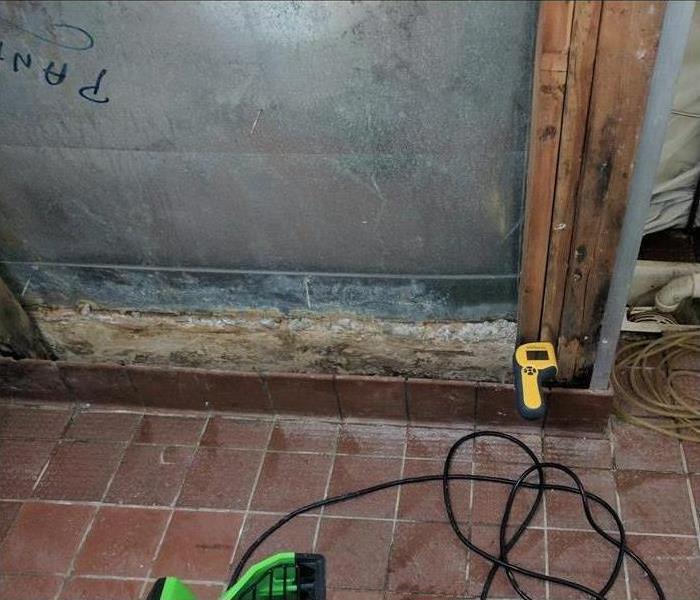 Mold requires moisture and humidity to grow and spread.
Mold requires moisture and humidity to grow and spread.
Mold Could Be Hiding in These 3 Places in Your Home
While finding mold growth in your West Orange, NJ, home can be distressing, you usually have options for cleaning it in a way that prevents it from returning. However, when mold starts to develop in places you cannot see, it can grow into a serious infestation before you notice its presence. If you want to kill mold in your home before it takes hold, it is wise to check out a few locations where it commonly hides.
1. Behind Drywall
Even small leaks, such as those that might seep from your refrigerator’s water line if it includes an automatic ice maker, can encourage mold growth in nearby walls. Drywall can be particularly affected because it is porous and absorbs water. Once moldy drywall and insulation develop, they must be torn out and replaced to prevent further growth from occurring.
2. Under Kitchen and Bathroom Cabinets
Mold requires moisture and humidity to grow and spread. This makes the areas under your bathroom and kitchen cabinets vulnerable, especially in far corners that can be difficult to see. It is a good idea to check these spaces often, especially in humid weather, and leave the cabinet doors open for a few hours a day so the wood and other building materials inside can breathe.
3. In the Basement
Your home’s basement makes a perfect hiding space for mold growth, especially if it tends to be damp all year round. Mold spores do not require sunlight to grow or spread, so spores that detach when you move stored belongings around can travel through your home’s air ducts and attach to wood and drywall in other parts of the house. Since mold on wood can be difficult to remove once it takes hold, consider calling in a mold removal and remediation service to inspect your home if you suspect a problem in your basement.
Hidden mold growth in your West Orange, NJ, home can be disastrous if it is not caught in time. Checking potential hiding spots often is one way to avoid this issue and to prevent future infestations.
Helpful Sump Pump Maintenance Tips for Homeowners
1/18/2022 (Permalink)
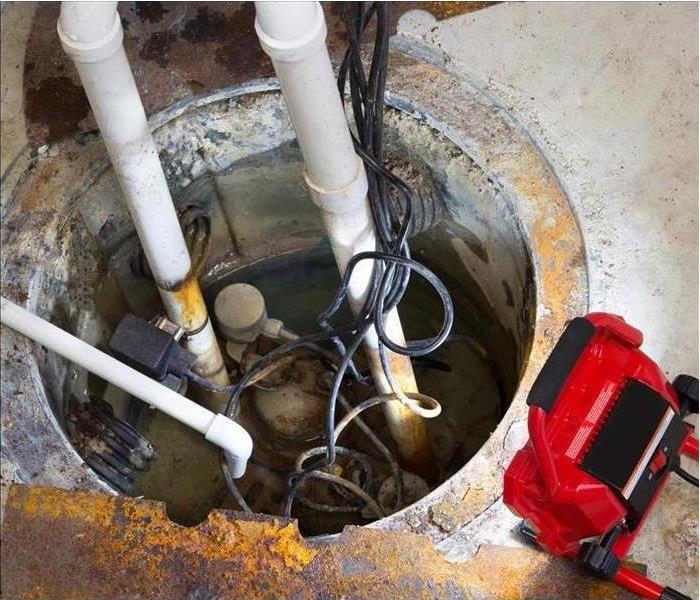 It's time to inspect your sump pump.
It's time to inspect your sump pump.
Helpful Sump Pump Maintenance Tips for Homeowners
As a homeowner in Glen Ridge, NJ, it might seem like the maintenance for your home never ends. Cleaning out the gutters and checking the roof for damage or leaks should already be part of your seasonal checklist, but have you thought to check your basement? More specifically, if heavy rains are in the forecast or spring is coming around the corner, it’s time to inspect your sump pump.
What Is It?
This device is used to remove any water that’s gathered in a sump basin, which is usually found in the basement. In the event of a basement flood, this pump is necessary to ensure that water is sent away from the house and into a place, such as a storm drain or dry well, where it will no longer be a concern.
How To Perform Pump Care
For your benefit and ease, you should be putting time aside every couple of months to confirm that your sump pump is working correctly. If you are unsure on how to go about conducting pump maintenance, look to the following tips:
• Occasionally flood the sump basin by pouring water into it to ensure the pump does what it’s supposed to do and drains the water quickly. Have it serviced if it doesn’t.
• Be sure that the pump is standing upright. Sometimes vibrations occur while the pump is running that can make it topple over or tilt to one side.
• Check the power cord to be sure it’s connected. It’s not uncommon for a breaker to trip in damp areas. If needed, reset the outlet.
The below can be limited to once a year:
- Clean out the sump.
- Check the manual (or online) to see if the pump bearings need grease or oil.
- Remove the pump from sump and clean and inspect it.
Learn Now, Protect Later
Though the preservation of your home is constant, the ease of knowing that you are capable of fixing your own sump pump is worthwhile. You can save time, money, and potential water damage to the rest of your home.
Smoke Damaged Electronics: Why You Should Always Call a Professional
1/4/2022 (Permalink)
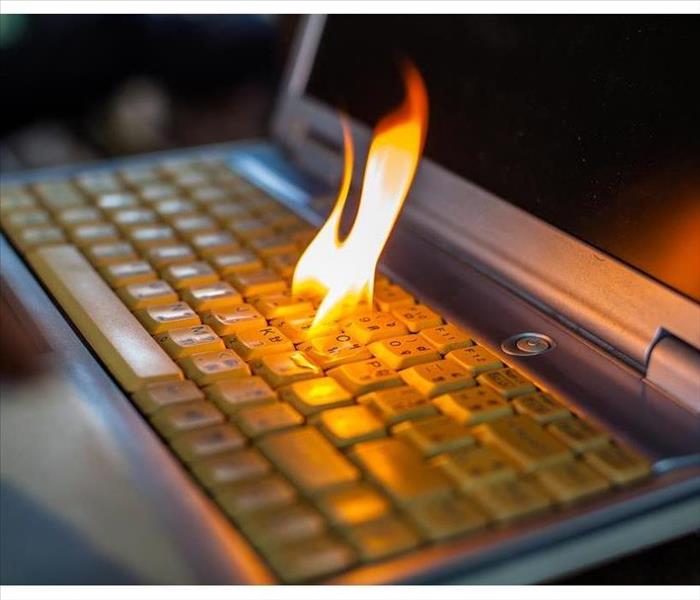 A regular or electrical fire can damage electronics.
A regular or electrical fire can damage electronics.
Smoke Damaged Electronics
An electrical fire, or any fire, can leave your electronics in disarray. While it is tempting to turn everything on and see if it still works, it is best to avoid powering on most items. There are elements of a fire that can be hazardous to your electronics, and that damage may become irreversible if powered on. It is best to leave the cleaning and testing to the professionals and avoid these common smoke damage pitfalls.
1. Avoiding Magnetic Charges
Though it may not be common knowledge, smoke does have a magnetic charge. This charge can short your laptops circuit board, or damage other machinery and appliances. To protect your laptop, you should take it in for a professional computer cleanup, letting the staff know about your concerns. Best case scenario, they save your computer; worst case, maybe they salvage your files.
2. Dealing with Black Film
A regular and electrical fire can leave a smoke residue on your electronics called black film. This film infiltrates the internal components of your items, insulating them and making them vulnerable to overheating. It is necessary to dismantle all parts and thoroughly clean them.
3. Removal of Acidic Soot
In addition to magnetic charges and black film, the remnants of soot on your electronics are acidic which can lead to degradation. This means that if the soot is not adequately cleaned off, your item’s life span will diminish, likely substantially.
4. Cleaning with Appropriate Equipment
While most businesses employ janitorial staff, it is important to note that electronics cleaning is a specialized field. Many janitors do not have the necessary tools or experience to clean electronics after a fire. You will likely want to hire a disaster restoration specialist in the Upper Montclair, NJ, area.
A regular or electrical fire can damage electronics. While the fire itself can be destructive, it is the smoke damage that does the most harm to these items. The intricate components and the variety of smoke, film and soot, make hiring a professional most beneficial.
 Knowing how to use a fire extinguisher can mean the difference between a small fire and a major disaster.
Knowing how to use a fire extinguisher can mean the difference between a small fire and a major disaster.






 24/7 Emergency Service
24/7 Emergency Service





























